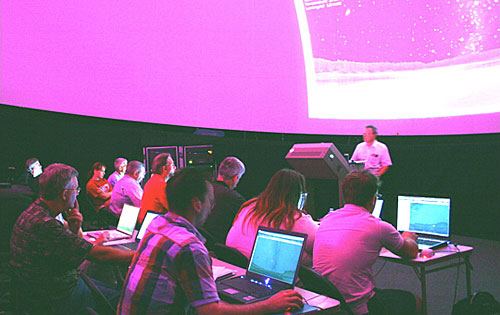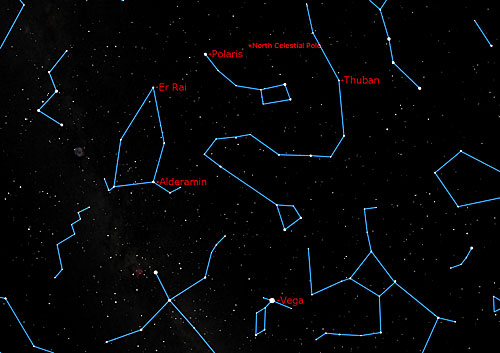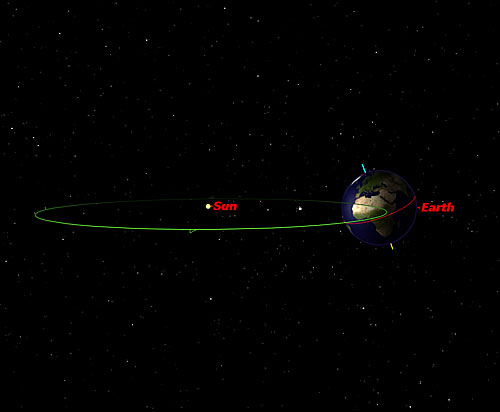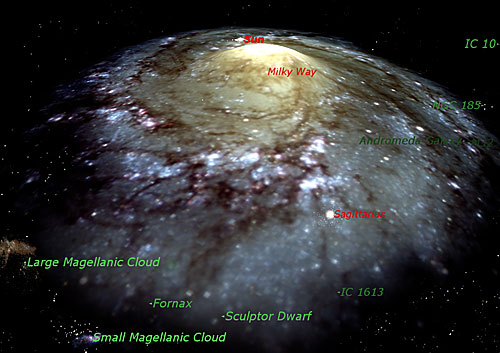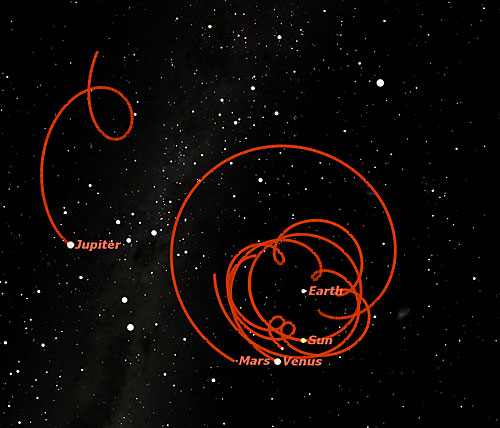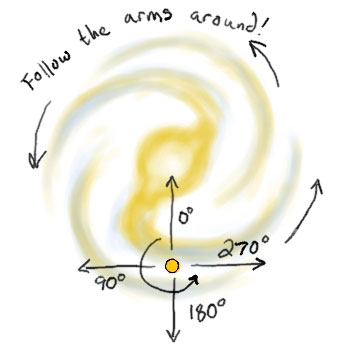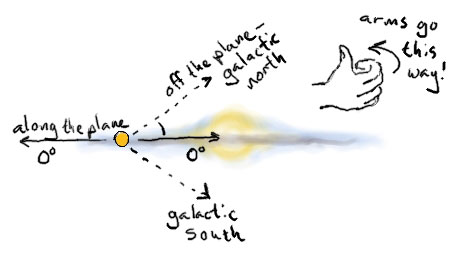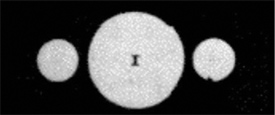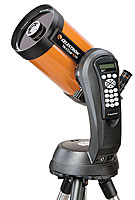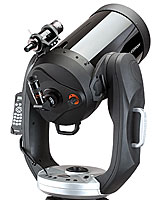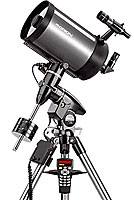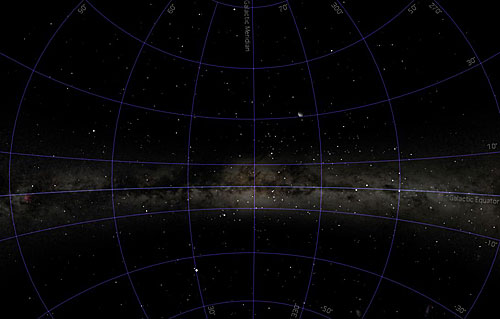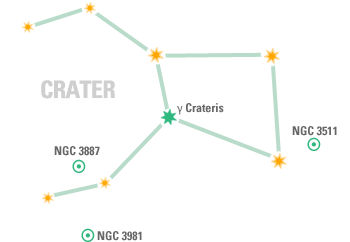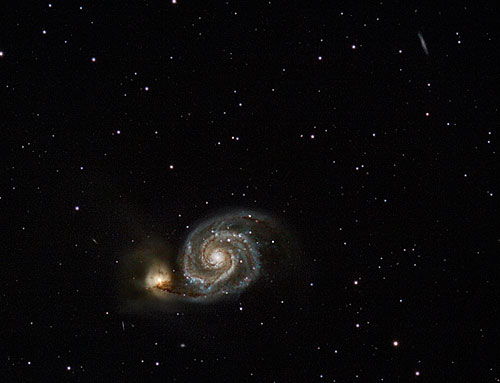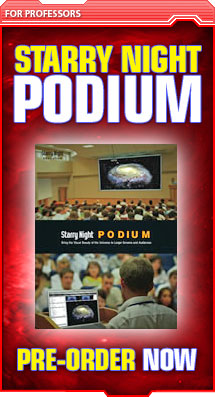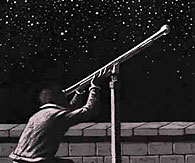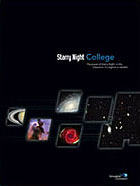 |
||||||||||||||||||||||||||||||||||||||||||||||||||||||||||||||||||||||||||||||||||||||||||||
|
If you have trouble viewing this newsletter, click here. Welcome again to our monthly educational newsletter with features on exciting celestial events, product reviews, tips & tricks, and a monthly sky calendar. We hope you enjoy it!
Digital astronomy enthusiasts, planetarium professionals and Starry Night® Dome users from around the world will gather this summer for the 5th annual Spitz Institute, a one week series of intensive courses, workshops and presentations about astronomy education. The Institute, scheduled for July 20 – 24, brings planetarium educators together to learn beginning and advanced topics relating to Starry Night®, astronomy curriculum, planetarium production, educational presentation and other subjects related to teaching under a dome. The Institute has a rich history, dating back to 1970, when Spitz brought planetarium professionals together at their Chadds Ford Pennsylvania headquarters to share techniques for teaching using traditional opto-mechanical star projectors. The event grew, and Spitz continued to host planetarians, well into the 1980s. The event became a popular gathering for advancing teaching in the planetarium. The Spitz Institute was given a new life in 2005, when it returned as The Digital Institute. “The development of our SciDome real time digital planetarium changed how we teach astronomy in domes, so the Institute has changed with it”, says Scott Huggins, Director of Marketing for Spitz. “Today, participants learn everything about education in the 21st century digital planetarium, from basic and advanced Starry Night simulation, to video production, to Photoshop techniques used to format images for the dome”. Starry Night educators have become part of the event, and participate as presenters and session leaders.
The Institute is also a great opportunity for astronomy educators to share ideas about space science education. Planetarium teachers from schools, colleges and museums get a chance to demonstrate their lessons, and share their teaching tips. They even work together in groups to develop original planetarium shows, which are presented to the Institute group at the end of the week. “Spitz Institute is a fun, creative way for planetariums to advance their teaching skills, and explore interesting new approaches to science interpretation” says Joyce Towne, Director of Customer Accounts. “Throughout The Institute's history, we've worked to make this event as valuable as possible to planetarium educators”. For more information about the Spitz Institute, visit www.spitzinc.com/institute
I used Starry Night® for many years before I started working for the company. I thought I knew everything there was to know about the program until I started to provide support for Starry Night® users. I found that our users knew amazing things about some of the more obscure features of this exceptionally powerful software. I'd like to share some of these things with you. My Favorite One! When my son was young, he used to describe many things as “my favorite one”! The Favorites menu in Starry Night® is a collection of some of our favorite demonstrations of the power of Starry Night®. Each item in the Favorite menu is a link to a Starry Night® file, with many settings preset. Some will begin operating as soon as loaded, others require you to set the clock in motion. The Favorites are conveniently arranged by topic so that you can find related files easily. By examining each file's settings, you can learn to make Starry Night® do your bidding. Let me show you some of my favorite Favorites. In each case I'll indicate the location within the hierarchical menu system.
Favorites:Guides:Precession This vividly demonstrates the precession of the Earth's axis. When you open it, it shows the position of the North Celestial Pole in the year 2000. Moving time forward or backward shows how the pole shifts in a 26,000 year cycle. Move backward to 3000 B.C. and you'll see that Thuban, Alpha Draconis, was the pole star when the Egyptians were building the pyramids; in fact one of the pyramids has a passage aligned on Thuban. Move forward and you'll see some of the future pole stars: El Rai (4000 A.D.) and Alderamin (7500 A.D.) in Cepheus and Vega (13000 A.D.) in Lyra.
Favorites:Solar system:Earth:Seasons This shows an enlarged Earth moving in its annual orbit and receiving differing amounts of sunlight in its Northern and Southern Hemispheres as the year progresses.
Favorites:Deep Space:Milky Way:The Milky Way What would it be like to view our Milky Way galaxy from a globular cluster orbiting its centre? This favorite shows you! Keep an eye out for the Sagittarius dwarf galaxy currently being cannibalized on the southern side of the Milky Way. Notice the stars in the vicinity of the Sun: they represent the tiny volume of space which we normally see with our naked eyes!
Favorites:Solar system:Inner Planets:Earth Centric Have you ever wondered what the Solar System must have looked like to the earliest astronomers trying to figure out how the planets moved? Take a look at this Favorite, and see just how confusing the Solar System looks if you assume Earth is at its center: Take some time to explore the dozens of favorites. What's your favorite one? Geoff Gaherty
The galactic coordinate system is useful for anyone interested in mapping the structure of or the distribution of objects within the Milky Way galaxy. As always, if you need a reminder on the basics of coordinate systems and angular geometry, read back through your last few issues of Starry Night® Times. The centre of the galactic coordinate system is the Sun (as a marker of the Earth's average position in the galaxy). If you look around you along the plane of the galaxy, you'd be changing the galactic longitude of your gaze; if you then looked up or down away from the plane, you'd be changing the galactic latitude. The zero point of galactic longitude is at the centre of our galaxy. How do you know which way to turn to go through 90º, 180º, 270º, and back to 0º? Follow the galaxy's arms as they spiral outward. (Note that this is actually the opposite of the way the galaxy rotates!)
How about galactic latitude? If you're looking at any point in the plane of the galaxy, the galactic latitude of that point is 0º. If you look away from the plane, how do you know whether you're looking north or south? The plane of the galaxy doesn't really line up well with either the plane of the solar system or the Earth's rotational axis, so we can't just project our own “north” onto the galaxy. Any coordinate system we impose on the galaxy will be a bit arbitrary by nature, but here's how it all fits together, with an easy way to remember it. Take your right hand, stick out your thumb, and curl your fingers (as if you were hitchhiking or reviewing a good movie). If you imagine that your fingers are curling in the direction of the galaxy's arms (and the direction of increasing galactic longitude), your thumb will be pointing towards the north side of the coordinate system. Here's the galaxy seen edge-on:
In Starry Night® Pro and Pro Plus, you can display a galactic coordinate grid (look under the Options tab -> Guides pane). Turn on some catalogues of objects within our galaxy, such as globular clusters, nebulae, and so on, and see if you notice any interesting distribution patterns with respect to the geometry of our galaxy. Brenda Shaw
In 1610 Galileo was the first person to look at Saturn and see its rings. But his telescope couldn't resolve fine details. To Galileo, it looked as though the planet had “handles” or large moons on each side of it (see figure 2). He said, “I have observed the highest planet (Saturn) to be tripled-bodied. This is to say that to my very great amazement Saturn was seen to me to be not a single star, but three together, which almost touch each other”. This observation was in a similar vein to that of Galileo's observations of Jupiter and its moons. They showed that bodies other than the Sun had smaller bodies in orbit about them, proving that everything would be in orbit about Earth.
Galileo's drawing of his observation of Saturn in the year 1610. You can travel back in time and relive Galileo's observation by downloading the file <Saturn1610.snf>. Describe the appearance of Saturn. How do your observations of Saturn compare with Galileo's drawings? Does Saturn have “handles”? How do you explain the differences between what you see in Starry Night® and what Galileo saw?
With a little imagination we can see why Galileo viewed Saturn as a “composite of three”. The bright ends of the rings do indeed look like two bodies almost touching Saturn. As usual at that time, Galileo preserved his priority by constructing an anagram the solution of which stated that Saturn was a “triple body”.
The confusion deepened when in 1612 the extra two bodies seemed to disappear.
In 1614 they came back and once again looked like handles attached to Saturn. Once you've downloaded the file <Saturn1610.snf> step time forward to see these changing views of Saturn. It wasn't until 1659 that Christian Huygens suggested that Saturn was surrounded by a ring that presented different aspects to us over time. Herb Koller
When I first got interested in astronomy many decades ago, the Schmidt telescope was a very rare design, used for only a handful of telescopes in professional observatories, notably the 48-inch Schmidt at Palomar Observatory. Like the Maksutov, the Schmidt telescope had a corrector plate at the front to correct the aberrations of its primary mirror but, instead of a thick deeply curved meniscus lens, it used a thin plate with a complex curve. Such plates were extremely difficult to figure until an amateur telescope maker got the bright idea of deforming an ordinary piece of plate glass to the proper shape against a metal template using a vacuum, and then polishing the exposed surface flat. This made it possible to mass produce Schmidt telescopes, in particular the Schmidt-Cassegrain design. The first company to mass produce such telescopes was Celestron, still one of the leading manufacturers of Schmidt-Cassegrain Telescopes (or SCTs for short) today.
The compact Schmidt-Cassegrain design allowed a large aperture telescope to be produced in a small package, readily transportable to dark sites, which had become a necessity because of the spread of light pollution. Equipped with motor drives and astrophotography attachments as standard equipment, the SCT drove the photographic side of the hobby to new heights. The 1990s saw computers being added to SCTs, and the modern GoTo telescope was born. Other telescope types compete in the marketplace, but the SCT remains the “Swiss Army knife” of telescopes: able to do most tasks well. The Schmidt-Cassegrain optical system has become standardized, still based on the original Celestron design of the ‘70s. They have been manufactured in sizes from 4-inches to 20-inches aperture, though the 8-inch size remains the most popular. Celestron introduced a new size, 150mm aperture, three years ago in the form of the NexStar 6SE <starrynight.com/sntimes/2007/07/>.
I purchased one of these and was so impressed with it that I also purchased the 11-inch version, the CPC 1100, which is now my main telescope. Mine has outstanding optics, and its goto system is reliable and accurate.
Both these scopes bear a strong family resemblance: the classic SCT tube assembly on a heavy-duty altazimuth mount. This is a convenient design for visual observers, since it's compact and doesn't require any counterweights, but it is very limited if your interests are in astrophotography. This is because the altazimuth design, while able to track objects accurately with its computer, does not compensate fully for the Earth's rotation. Long exposures result in field rotation: while the center of the image tracks correctly, stars on the edge of the field leave trails. To get complete and accurate tracking, Orion offers these tube assemblies on what is called a German equatorial mount, or GEM for short. These mounts are “German” only in the sense that they were originally designed in the early 19th century by Joseph von Fraunhofer, who also developed the achromatic telescope objective, the diffraction grating. and discovered the absorption lines in the solar spectrum.
The German equatorial mount is designed around a polar axis, which is carefully set parallel to the Earth's axis of rotation by pointing it at the north celestial pole, close to Polaris, the pole star. A motor drive turns the telescope around this polar axis at precisely the same speed as the Earth is turning in the opposite direction, exactly compensating so that the telescope ends up pointing at a fixed point in space. Orion offers their Schmidt-Cassegrains on several different mounts, depending on the size and weight of the telescope. If photography is in your plans, you should seriously consider a German equatorial mount. Another advantage of a GEM is that it breaks down into relatively light weight components for transport, rather than being one massive unit. Whether you choose the altazimuth or GEM mount, these telescopes are easily controlled by Starry Night®. The Schmidt-Cassegrain system offers by far the most compact telescopes of their aperture. An 8” SCT, although having a focal length of 2032 mm (80 inches), is housed in a tube which is only 18 inches long! The main disadvantage of the design is the large central obstruction, which has a slightly deleterious effect on image contrast. But that is a small price to pay for having such a large telescope in such a compact package. Accessories 'R' Us Because the modern Schmidt-Cassegrain has been around and standardized for over 30 years, it has a well-developed system of accessories for both visual observation and imaging, making it the most versatile telescope on the market. The standard 1.25” eyepiece system is easily replaced with a 2” system, allowing for wider fields of view. These eyepiece systems are easily replaced with imaging systems. An essential accessory is a flexible dew shield which protects the telescope's corrector lens from dew. It can be truly said that the Schmidt-Cassegrain telescope revolutionized amateur astronomy. Its compact elegant design, combined with its power and versatility, has made it the best selling design among serious amateur astronomers. Geoff Gaherty
Galactic Object Distribution Starry Night® allows you to turn off and on various Deep Sky objects to demonstrate their distribution in the sky relative to the Milky Way. Start by opening the following file in Starry Night: <Galactic Object Distribution.snf>.
In the Options pane, start by selecting different groupings of objects from within the NGC-IC Database. To view the NGC-IC Database, open the Deep Sky layer in the Options pane. Then expand the NGC-IC Database layer to view the different groupings of objects. For example, check the Open Cluster box, or Planetary Nebula, or Globular Cluster, or Galaxy. The closer the distribution hugs the Milky Way plane, the more it is assuredly associated with the Milky Way. Note how most objects have a distinctly planar distribution along the Milky Way, whereas globular clusters are centrally distributed about the galactic center. Note also how the galaxies appear to "avoid" the plane, leading to all kinds of confusion in the early part of the 20th century. The distribution of objects in the sky can evoke all kinds of worthwhile discussions. Ask other users or research on the internet what these distributions might be telling us about the objects, their ages, and membership in the Milky Way or not.
Crater is a dim constellation that glides across the southern horizon at this time of year. It lies to the west of Corvus, above Hydra, and below the boundary between Virgo and Leo. Three faint galaxies are worth bagging and comparing...
Lastly, γ Crateris is a pretty 4th magnitude fixed binary star that should be fairly easy to "split" in your telescope. Sean O'Dwyer
The Whirlpool Galaxy (M51) and NGC 5195 by Wynn Myers At magnitude 8 and at a distance of 23 million light years, the galaxies appear to be pulling each other apart. This image was taken from our dark sky location near Uwharrie, NC. on Feb. 21, 2009. Seeing was excellent. The temp was 15 deg. F.
RULES: We would like to invite all Starry Night® Education users to send their quality astronomy photographs to be considered for use in our monthly newsletter. Please read the following guidelines and see the submission e-mail address below.
|
APR 2009
|
|||||||||||||||||||||||||||||||||||||||||||||||||||||||||||||||||||||||||||||||||||||||||||
 |
||||||||||||||||||||||||||||||||||||||||||||||||||||||||||||||||||||||||||||||||||||||||||||
|
|
||||||||||||||||||||||||||||||||||||||||||||||||||||||||||||||||||||||||||||||||||||||||||||
You have received this e-mail as a user of Starry Night® or as a registrant at starrynighteducation.com
To unsubscribe, click here.
